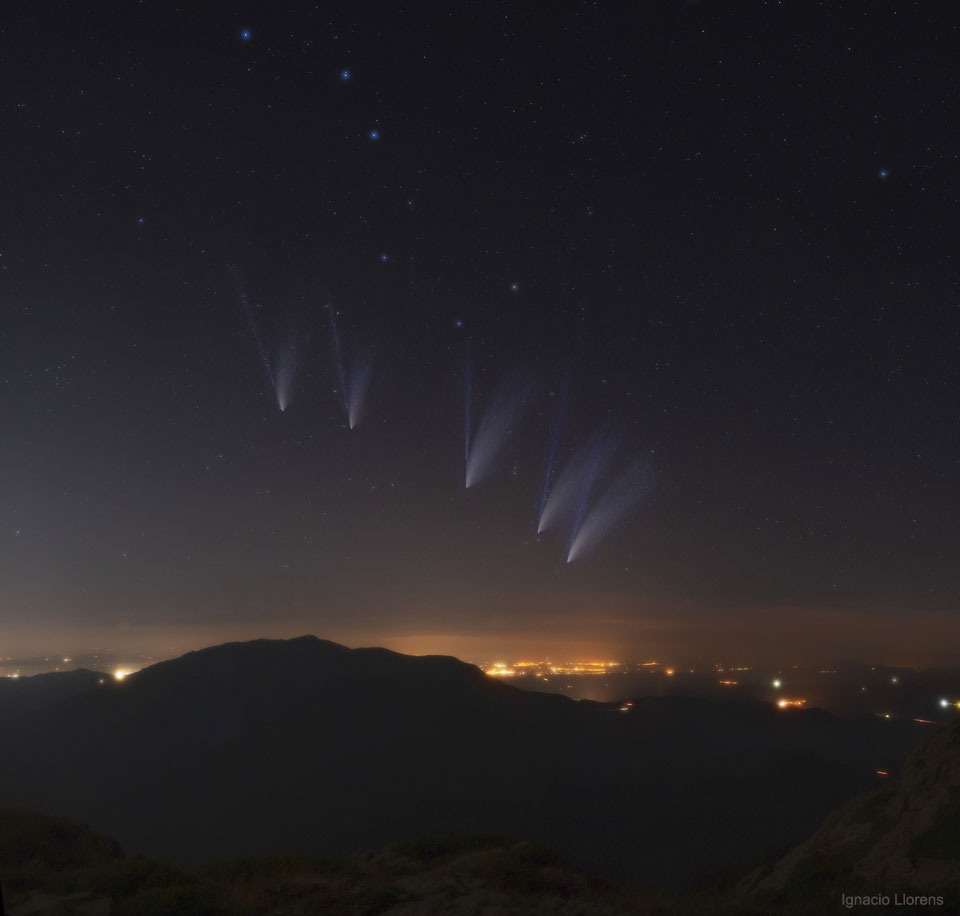2020年8月12日
The Shifting Tails of Comet NEOWISE
Image Credit & Copyright: Ignacio Llorens
Explanation: Keep your eye on the ion tail of Comet NEOWISE. A tale of this tail is the trail of the Earth. As with all comets, the blue ion tail always points away from the Sun. But as Comet C/2020 F3 (NEOWISE) rounded our Sun, its ion tail pointed in slightly different directions. This is because between 2020 July 17 and July 25 when the featured images were taken, the Earth moved noticeably in its orbit around the Sun. But the Earth’s motion made the Sun appear to shift in the sky. So even though you can’t see the Sun directly in the featured image(s), the directions of the ion tails reveal this apparent solar shift. The Sun’s apparent motion is in the ecliptic, the common plane where all planets orbit. The featured five image composite was meticulously composed to accurately place each comet image — and the five extrapolated solar positions — on a single foreground image of Turó de l’Home Mountain, north of Barcelona, Spain Comet NEOWISE is no longer the impressive naked-eye object it was last month, but it can still be found with a small telescope as it heads back to the outer Solar System.
Tomorrow’s picture: open space
NEOWISE彗星移动的彗尾
影像提供与授权: Ignacio Llorens
说明: 请细看NEOWISE彗星的离子尾。因为彗星的离子尾,叙说着地球绕日公转的故事。就像所有的彗星一样,NEOWISE彗星泛蓝的离子尾永远指向远离太阳的方向。不过在这幅影像里,随着NEOWISE彗星(C/2020 F3)绕行太阳,它的离子尾之指向也有些微的变化。这是因为在2020年7月17日到7月25日期间拍摄这幅主题影像时,地球在绕日轨道上移动了不小的距离。因为地球的运动,会造成太阳在地球天空中的移位。是以,纵然太阳并未直接出现在这幅主题影像里,离子尾的指向反应了太阳的位移。太阳进行视运动的黄道面,也是所有行星绕太阳公转的轨道面。这幅由5张照片精心合成的主题影像,精确的记录这颗彗星每晚的位置,以及在摄于西班牙.巴塞隆纳北边的图罗德霍姆山之前景照片上,外插出的5个太阳位置。如今踏上返回太阳系外围旅程的NEOWISE彗星,不再是上个月那个肉眼可见的精采 天体,但仍然是小望远镜可见。
明日的图片: open space







